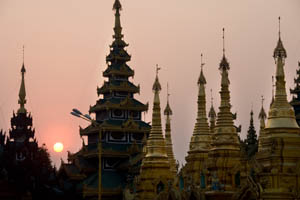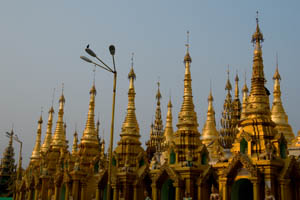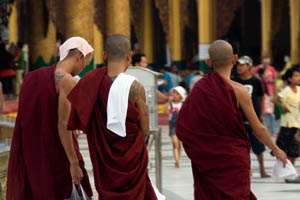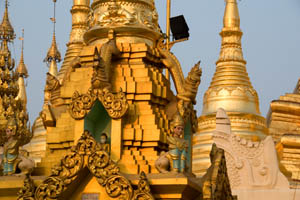Sunday, 13 April 2014
Mandalay, Myanmar
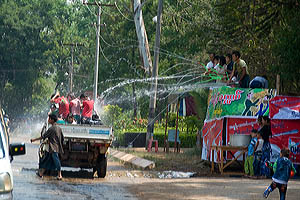
(Mandalay, Myanmar)
We had travelled to Singapore the night before and had taken the morning flight to Yangon. We arrived at 0930 and our driver for the next two days Tun Tun was waiting at the airport to pick us up. He bought his minibus around to the front of the airport and we jumped in and set off on the long drive to Mandalay.
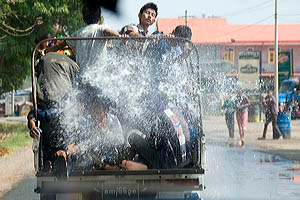
(Mandalay, Myanmar)
We had arrived in the middle of Thingyan the water festival which is a week long public holiday. As a result we had not wanted to loose two days getting anywhere by bus so had afforded ourselves the luxury of a car and driver to get us to our first destination Hsipaw in Shan state to the northwest of Mandalay. This turned out to be a very good call as Thingyan, as we had been warned, did involve locals doing nothing but tipping and squirting copious amount of water over each other. We would have had difficulty getting to a bus station, would have got very wet in the process and (it turned out later) would have found no buses.
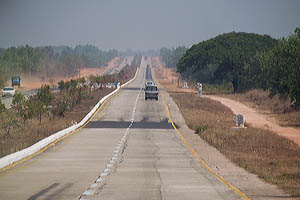
(Mandalay, Myanmar)
It did not take us long to get out of Yangon and pretty soon we were on the road to Mandalay. It was slightly better than a road, it was Myanmar's one and only motorway. The road however has not been resurfaced for a while so Tun Tun had to drive at 50 for most of the 400 miles. That would have not been a problem but for the fact that the road is intensely dull. It cuts through a fairly barren landscape denuded of trees and very sparsely populated by people. The only features are two service stations, one at 115km and another at 250km. We reached The outskirts of Mandalay at around 1730.
The scene in town was one of absolute chaos. Every 100m would be a set on teenagers equipped with buckets ready to soak passing motorcyclists. Scattered around the city were raised stages with singers and helpers equipped with hoses spraying crowds of dancing revelers. We worked our way through and found the hotel by the side of a canal to the North of the city. This was a relatively luxurious teak affair complete with swimming pool and restaurant. The hotel restaurant proved to be useful as a dusk walk around the local area revealed that all the restaurants were closed for the holiday. We had the first of several Myanmar Set Menus and more than a couple of beers and then settled in for the night.
Monday, 14 April 2014
Hsipaw, Shan, Myanmar
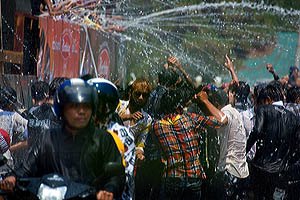
(Pyin Oo Lwin, Shan, Myanmar)
We got up relatively early and were on the road by 0900. We worked our way up into the hills and within two hours were at Pyin Oo Lwin . This was the summer retreat of the British during the days of the empire but from what we saw relatively little of this remains. What we saw instead were more huge parties of soaked revelers during our brief round of the lake.
Thingyan was unbelievably chaotic. It appeared the entire nation does nothing except dance, drive around getting soaked or standing around with buckets and hoses doing the soaking. Since it was the height of the dry season I could understand the attraction of dancing under a hose for eight hours a day for four days. However I could not imagine that much gets done.
After Pyin Oo Lwin the road snakes it's way across the Shan plateau. We stopped for a while at a village for a cup of coffee and worked on our Burmese with Tun Tun. At Golteik a 1901 steel rail bridge precariously teeters over a huge gorge whilst the road plunges straight in requiring countless hairpin bends to be negotiated to reach the opposing lip.

(Hsipaw, Shan, Myanmar)
The scenery on the trip would have been spectacular had it not been for the extreme amount of deforestation. Pretty much all of the hillsides for Pyin Oo Lwin to just before Hsipaw had been cleared of their teak forests. This would have been partly excused if farms had sprung up in their place but instead a large percentage of it has been left as barren scrub. We even saw logging lorries suggesting the Trees continue to be cleared even beyond the main road. We hoped Hsipaw was not similarly stripped.
We got to Hsipaw at 1430 and were thankfully rewarded with a leafy town besides a wide river. Our hotel was on the opposite bank of the river facing the main town so required a bit of driving around to find it. Once there we said goodbye to Tun Tun and collapsed onto our verandah thankful of at last being able to stop moving. We spent the afternoon chilling out and had dinner on the restaurants excellent terrace restaurant watching the sun go down over the rive Dothawaddy?
Tuesday, 15 April 2014
Hsipaw, Shan, Myanmar
Having got ourselves as fast as we could to almost the middle of nowhere we were determined to enjoy it. We had given ourselves the day to arrange going trekking, start working out how we would get back to Mandalay and just generally relax. In recent years we had made things a little bit easier for ourselves by arranging everything from London. We had decided we were a bit sick of this as it makes everything less exciting. As a result we had not arranged anything past our hotel in Hsipaw.
We got lucky with the guide as the hotel manager had an unofficial relationship with a guide called Sandy who was prepared to work on Thingyan. The manager could have also arranged for us to get back to Mandalay but we decided to set ourselves a challenge and save a bit of money by finding some other tourists to share the car. We got the hotels boat over to the town centre and went to check out what our guide book reputed to be the travellers hang outs.
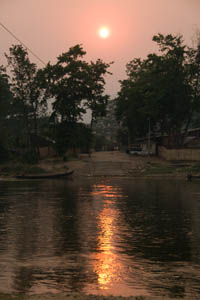
(Hsipaw, Shan, Myanmar)
Getting around the main town in Thingyan proved to be difficult without getting soaked. I would have enjoyed the whole business a lot better had the local kids not taken particular delight in getting the water in your face. We had seen the kids fill the water from the river and all the locals took their buffalo to cool off in the river so I was not keen to swallow any. You could avoid the worst of it with roadside shakers by waiting for them to empty their buckets over a motorcyclist. But in the side alleys you would encounter gangs of roving kids with water pistols who could not be avoided once they had spotted you.
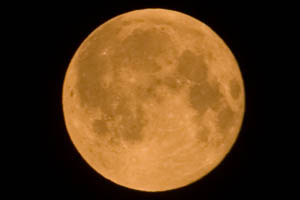
(Hsipaw, Shan, Myanmar)
We checked a cafe where there was not a lot happening but the most well known travellers guest house we saw a sign for a shared car the next day and knew this was the place to advertise. We left a note with them and promised to return in two days time.
We had already seen quite a bit of Hsipaw and it was mainly closed so we decided to head back to the hotel and spend the afternoon chilling out in the sun on our riverside terrace. We followed a very lazy afternoon up with dinner by the riverside watching the sunset again.
Wednesday, 16 April 2014
Tangchan, Shan, Myanmar
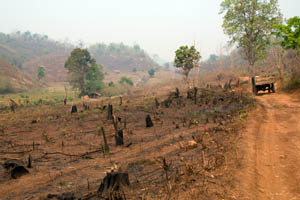
(Tangchan, Shan, Myanmar)
We set off at 0800, a bit later than we were hoping. Sandy shoved us in a Tuk Tuk which helped to bypass a half hour walk up the Mandalay road. We then had to get through a couple of Shan villages for which we put on our rain coats and so avoided a soaking. After this it was almost plain sailing a gentle walk up through the fields and then zigzagging up through the forest. Unfortunately there was again a lot of forest that had been cleared through fairly recent looking burning. Talking to Sandy his theory was the villages were clearing a lot more than they used to because the price of corn was high.
The next village was more of a challenge to get through unscathed as the local children had erected a barricade. As we were feeling tired Sandy decided to pay off the local children, buying them all a sweet in order that we avoid getting soaked. After buying the sweets we had a cup of tea in the shop before setting off to crack the slow ascent up to Pankam.
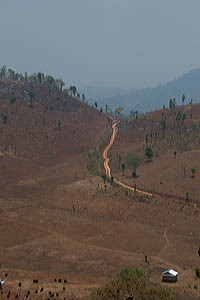
(Tangchan, Shan, Myanmar)
It is rare that we dislike bits of walks but getting up to Pankam, 1100 to 1300, was an unpleasant slog. Most of the trees had been cleared almost all the way up to the entrance to the village and this left trudging along a bright red dusty track in the searing midday heat through a wasteland of dusty fields punctuated by the odd tree. Talking to Sandy I explained that whilst it is right that people need to make money to live but they were clearing near vertical areas right up to the tops of ridges. Whilst I assume it's practical to grow corn at these angles with it having little roots and being absent for several months of the year the villagers were exposing themselves to loosing a lot of the soils nutrients through rain and worse landslides. The traditional crop for these slopes which we were to see growing further on is tea whose bushes to an extent hold the hillside together.
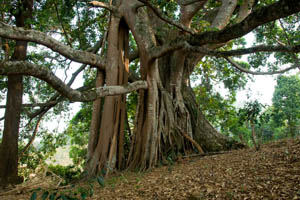
(Pankam, Shan, Myanmar)
Sandy was also cross about the loss of nature. It seems a small sacrifice to leave the heads of valleys and tops of ridges as forest so that there is some joined up environment for nature, and using the valley floor for agriculture. Even the occasional tea plantation was much less intrusive than these wholesale clearings. As far as our walk was concerned it made it fairly unpleasant and when we got to Pankam, the first Palang village, we felt a bit short changed. As a result we decided that we would have some lunch in Pankam to sit out the worst of the heat and then carry on to the next village Tangchant.
Lunch was a fairly unusual affair at a shop which also doubled as a restaurant which most of the village seemed to pop into at some stage of the afternoon. Anna played with some of the local children who were dressed in their best clothes for the celebration, we also chatted to Sandy about education. It turned out that the majority of village children go to primary school up to the age of ten but since education beyond that involved going to a boarding school in Hsipaw most did not have the money. The twenty year old daughter of the shop owner who spent most of the afternoon cooking was no exception to this having only been educated to the age of ten. Sandy also revealed he had a son but despite being a fairly well off family with their own tea plantation who could afford to educate him they lost him at the age of thirty five to drug addiction. It is a fairly chilling fact that drug addiction both to heroin and methamphetamine is a big problem.
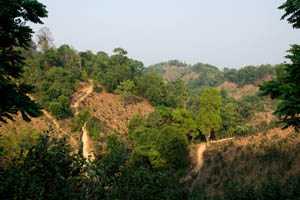
(Tangchan, Shan, Myanmar)
Anyway around four some very burnt fellow hikers turned up and we chatted to them. They had not managed to find a guide willing to work the holiday so had to battle on their own through the Martian landscape before Pankam in the hottest part of the day. They also told us there had been no buses from Mandalay so they had to take the train so again I felt we had made a good call as the train takes a good twelve hours and crosses the 112 year old Golteik viaduct.
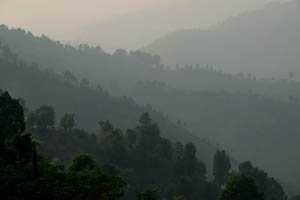
(Tangchan, Shan, Myanmar)
We then set off for Tangchan. This proved to be the best bit of the two days walking, we walked up by the town's Banyan tree and then in the late afternoon sun, the golden hour, traversed several ridges to reach the next village. The views were spectacular, looking over preserved tree filled valleys with only the occasional tea field interrupting the trees. The tea was quite unlike what you see in India. Rather than rows of close packed low bushes the tea plants were quite tall spindly things randomly dotted around the slopes. I was interested whether Sandy had considered using the Indian system on his fields, he did not know so I suspected for some reason it is not feasible.

(Tangchan, Shan, Myanmar)
On the way we even spotted a wild peacock rummaging around in the undergrowth. It is hard to explain how happy we were for an hour working our way through jungle ridges. However despite being totally tired we were rather disappointed when we ran into the village gates of Tangchan next to another Banyan tree at a low hill pass.

(Tangchan, Shan, Myanmar)
Tangchan was itself arranged along a ridge with its Monastery and stupa at the highest point. We walked through the village and then came to a stop at a courtyard halfway through. Our lodgings for the night were at the Tangchant Hilton, a single room with a mat above the village's old wood built shop. It really was a shop, as we settled in had a few beers then dinner all manner of custom came in all the way from kids buying sweets, farmers selling tea to a farmer dropping off a delivery of pork belly which was dutifully weighed in front of our eyes. It truly was a small village and we were at the centre of it.
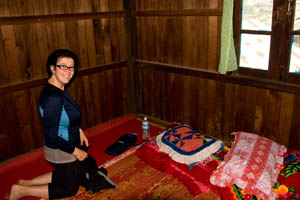
(Tangchan, Shan, Myanmar)
After dinner we were invited to the end of water festival celebrations at the monastery however this went a bit wrong. We turned up at the monastery and some local teenagers were playing around with the monastery drums with no clear sign that anything formal would happen. After about three quarters of an hour we gave up and decided to go to bed. We will never know if there was a celebration or not as once our heads hit the pillow one of the shops neighbours decided to start playing his own festival music at full blast. In between the tortured tracks which were virtually indistinguishable I made out noises from the monastery which may have been more in tune but it was really tough getting to sleep for an hour or so.
Thursday, 17 April 2014
Hsipaw, Shan, Myanmar
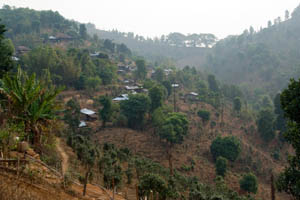
(Hsipaw, Shan, Myanmar)
At 0400 two things happened. Some music started blaring out of nowhere and lightening lit up the sky. The former it turned out was some wake up service the monastery runs to get villagers up to pick tea whilst it's still cool. The thunderstorm however meant everyone had to rush around packing away the tea they all had out to dry. We tried our best to ignore both and carry on sleeping until around 0645. Sleeping done we got up and had breakfast and left to get some more of our hike done. This involved working our way down a forested ridge to a paddy field in a valley and then up to another pass to get to the village of Ong Mu.
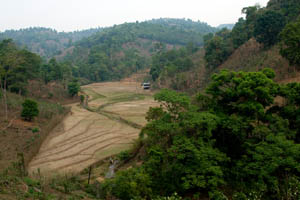
(Hsipaw, Shan, Myanmar)
This part was nice and although we did not see another peacock we heard one and plenty of other birds. The mountain forest was much better preserved in this area and we were happy we had a guide who could take us out a different way. After Ong Mu it was a two and a half hours slog along a tarmac road to Bawgyo. This was not great but the scenery was a little less depressing than leading up to Pankam as although there were plenty of fields they were all in the valley floor with plenty of woods on the hillsides.
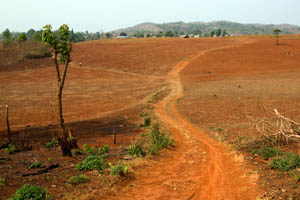
(Hsipaw, Shan, Myanmar)
At Bawgyo we almost collapsed into a cafe and had a beer whilst Sandy called a Tuk Tuk. We were back on the main road so it was time to stop walking! We had a couple of well deserved cold beers and when our Tuk Tuk arrived the driver joined us for one before we all set off together.
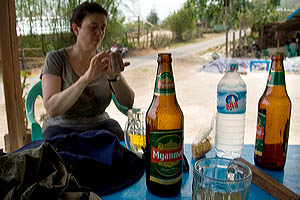
(Hsipaw, Shan, Myanmar)
Back at Hsipaw we found that the traveller guest house had found us someone to share a taxi with. So we had nothing else to do but head back to our hotel to get ourselves clean, the Tangchant Hilton having no showers we had not washed in two days. After this it was around three so we followed the usual routine at our hotel of hanging out on our verandah enjoying the sun and watching the river go by.
Friday, 18 April 2014
Mandalay, Myanmar
At the guest house we got a bit of a surprise when our shared taxi finally turned up, the other two occupants were actually two guys from Myanmar. As the journey progressed we got chatting to them and found that they were a goldsmith and a civil servant. Both of them had been taking advantage of the public holiday to go on a retreat in Lashio where they got to be "temporary monks" as they put it, for the duration of Thingyan.
They told us a lot about the country and how things were improving under the new relaxed government. They also pointed out some less well known sites like Tombo, a prison camp and quarry where the prisoners break rocks for their sentence. They also told us a bit about monks, how for example children are not considered to be full monks until the age of twenty.
We stopped for lunch at some appalling fly infested road stop and picked up some strawberries at Pyin Oo Lwin which were really quite nice. When we finally made it to Mandalay we were all good friends and swapped addresses.
In Mandalay we stayed at the same hotel we had stopped in on the way up but this time everything was more or less open so we were able to have dinner outside the hotel. Having had curry for the last five days running we opted for something western and went to cafe city which was decked out like a diner, and had pizza - a welcome break.
Saturday, 19 April 2014
Nyang U, Mandalay, Myanmar
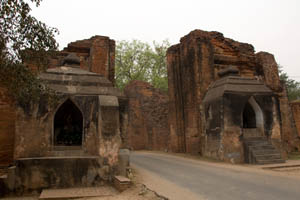
(Bagan, Mandalay, Myanmar)
Our hotel had kindly arranged our onwards bus to Bagan which left at 0830. I would like to say it was an interesting trip but the scenery of the central plains is very repetitive in the dry season. More along the lines of an African Savannah than a lush tropical landscape. One thing that was interesting was the state of the roads once off the central motorway. Although quite recent it was single track meaning the bus would frequently have to pull over to pass opposing traffic.
Crossing a couple a dry river beds was also an interesting experience as the road had been washed out. At one we had to switch to driving on the railway bridge which seemed fine since there were no trains, at another we had to drive through the dirt whilst small children with brooms tried to sweep the sand away for no apparent reason. It was slow going and we got to Bagan at 1330. We had foolishly not arranged for the hotel to pick us up so had to haggle for taxis and got to our hotel around 1400.
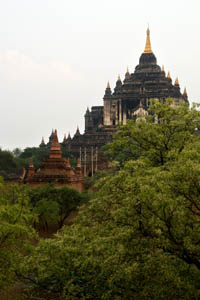
(Bagan, Mandalay, Myanmar)
The hotel was indulgently luxurious, it was a series of villas and rooms set in lush tropical gardens with an infinity pool which looked out over the plains so you could effectively swim whilst temple spotting. To top that our room was set in a small square of low buildings which also had its own swimming pool. We spent the middle of the afternoon at the pool as it was too hot to venture out.
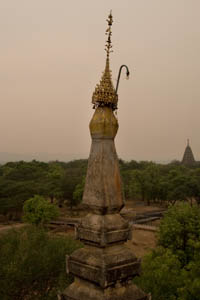
(Bagan, Mandalay, Myanmar)
Around 1600 we caught a cab to Old Bagan and started to walk from the Tharabar Gate. We were to have a mixed experience of Bagan with this being the low point. The first thing we noticed were the cars, nearly everyone else was driving from temple to temple in a car or motorbike. This was the driest hottest part of the year and it appeared the atmosphere was conspiring to trap all the pollution from the cars in the site. You could literally see the fumes and it was difficult to breathe.
We visited Thatbyinyu Pahto and walked around it and then went to its upper level. It was undeniably picturesque but you still could not escape the fumes. We then walked through a local village and out to the shore of the Irrawaddy to take some photos of the setting sun. It was peaceful by the river and we were able to enjoy walking through the rushes of its flood plain for a while until a pack of dogs turned up. We then decided to head to Nyang U for some dinner.
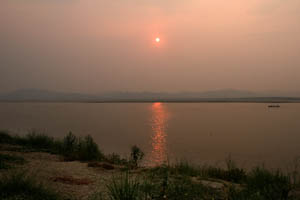
(Bagan, Mandalay, Myanmar)
This was not without event, first off the only transport we could find for the three miles were the horse drawn carriages which, given the heat, I thought were a bit cruel. Nevertheless we jumped in one and trotted off and about twenty minutes later were in the dusty streets of Nuang U. Then we had a lot of fun finding a restaurant, with one popular place being so incredibly rude that on asking for a table the waitress just pointed in a general direction and turned our back on us. Eventually we settled on a small Thai place down a side alley.
This turned out to be the best decision we made all day. The meal was made on the spot by a (presumably) Thai couple. It was so small every time we ordered a beer the waiter, their son, would get on his bike and drive round the corner to an off license to get a cold beer from the fridge. The meal was $10 plus beer but we gave them a $4 tip as they were so attentive.
Sunday, 20 April 2014
Nyang U, Mandalay, Myanmar
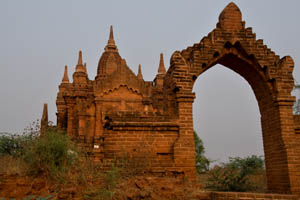
(Bagan, Mandalay, Myanmar)
We had rented some electric bikes from the hotel and jumped on them to have another shot at exploring the ruins. This went a lot lot better than the previous evening. Most people do not start visiting temples until nine which is crazy as the light is so much better at seven. We were able to zip around on our bikes and get to a few of the big ones before most people turned up.
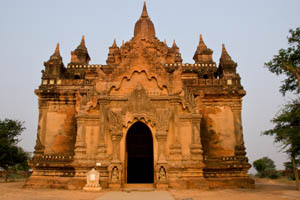
(Bagan, Mandalay, Myanmar)
We started off at a small temple near our hotel. The sun was slowly climbing into the sky so the temple had a warm red glow to it. There are over 2,000 surviving temples on the Bagan plain so many of the smaller ones are not named in guide books. The temples were built between 1000 and 1200AD by the Pagan empire which collapsed partly due to the fact that it gave most of its wealth away to Buddhist institutions to earn religious merit. We then popped into the Tayok Pye Pahto built by the last Pagan king who fled the empire in the face of a Mongolian invasion in 1287. Here the guard was extremely nice and showed us around with a torch, refusing to take any payment.
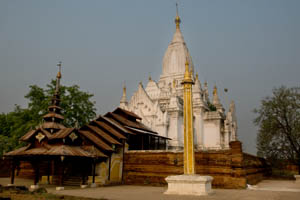
(Bagan, Mandalay, Myanmar)
Next we visited the larger and white Leimyethna Pahto. This was built by a minister of the court of Htilominlo, who ruled to 1235 at the beginning of the end for the empire. After this we got on our electric bikes and attempted to go cross country. This was much harder than it sounds as a lot of the smaller tracks crisscrossing the Bagan plain accumulate sand. If you have ever tried to cycle over loose sand you will know it is nearly impossible and this does not change much when the bike is electric. You get stuck in patches of sand, loose control of the steering and all manner of difficulties. Nevertheless it was fun and we finally got to the Sulamani Pahto.
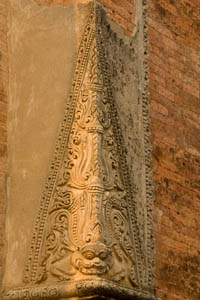
(Bagan, Mandalay, Myanmar)
The Sulamani Pahto was built in 1181 at the height of empire and has some of the most ornate brickwork in Bagan. It was heavily damaged in an earthquake in 1975 so a lot of what you see today is a reconstruction. Inside the temple a gallery runs all the way around the inside of its square profile with a large Buddha sitting in the middle of each of the faces. There are also several smaller gilded Buddhas staring our through windows. We stopped for a while to watch a few local tourists climb up a ladder to brush sheets of gold leaf to one of the Buddhas.
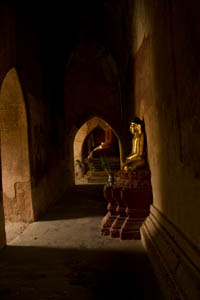
(Bagan, Mandalay, Myanmar)
We then carried on to the Dhammayangyi Pahto, which is one of the most infamous temples as it was built by King Narathu to atone for the sin of killing his father and brother. During the building more blood was shed as he amputated the arms of any masons who did not ensure blocks of the temple fit closely enough together. By this point of the day either the sun was too bright or I had temple fatigue as I have no photographs of the temple.
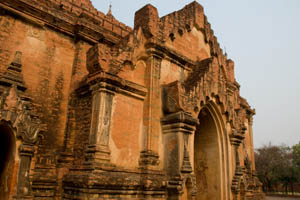
(Bagan, Mandalay, Myanmar)
We got back to the hotel at 1030 ready to start our day of leisure. We spent some time at the pool, then had lunch, went back to the pool again then had dinner. It was unmitigated relaxation! The only sour note was trying to book an onwards bus. It was the end of the public holiday in Myanmar so everyone was trying to get home so every bus on Monday night was booked solid. All we could get was a seat at the back of a night bus on Tuesday night. We had to take it but resolved to look for another way.
Monday, 21 April 2014
Nyang U, Mandalay, Myanmar
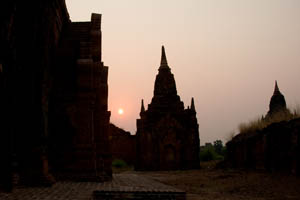
(Bagan, Mandalay, Myanmar)
Pretty much a replay of the previous day. Zipping around temples on electric bikes in the morning, we visited a couple but had a great deal of difficulty finding the smaller ones listed in our guide book as they were not sign posted in English. However we were having so much fun zipping around the area on dirt tracks we did not really care.
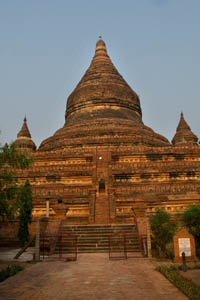
(Bagan, Mandalay, Myanmar)
We did manage to find the Mingalazedi Paya , built in 1284 it is one of the more beautiful solid stupas. It still has some of its glazed tiles intact. We walked around its upper level admiring the view over the plain and generally trying to avoid the sun.
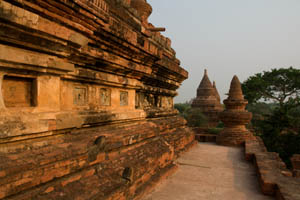
(Bagan, Mandalay, Myanmar)
We got back to the hotel in time for breakfast and then settled in for a day of leisure.This is when disaster struck on the onwards travel front. We were maybe trying too hard to get one more destination in and had set our sights on Ngwesaung beach. Whilst we had just about got a bus ticket to Yangon on Tuesday night we would not be able to get across town to make the connecting bus to the beach on Wednesday am. Since we had a pretty bad bus ticket we then explored getting someone to drive us all the way from Bagan which would be a twelve hour drive.
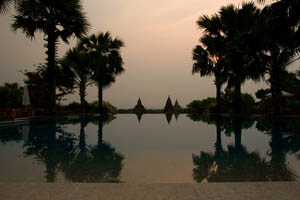
(Bagan, Mandalay, Myanmar)
We got one high quote then called another agency who gave us a lower quote which we accepted. However a few hours later they called back and told us the driver had changed his mind and was now wanting a larger amount of money. We suspected there was some collusion so with great disappointment decided to ditch the idea of a car all the way and revert to a bus plus car from Yangon. It appeared with bad roads and over crowding on the buses the cost of private hire had been driven up substantially and drivers can more or less ask whatever they want.
Apart from that the rest of the day was relaxing by the pool followed by dinner in the evening. We resisted the temptation to go out sight seeing in the afternoon as the pollution just makes it unpleasant.
Tuesday, 22 April 2014
Nyang U, Mandalay, Myanmar
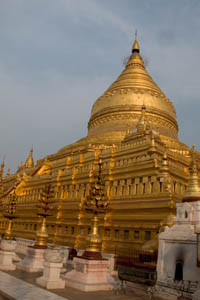
(Nyang U, Mandalay, Myanmar)
We again spent the morning zipping around on electric bikes exploring the last few temples on our hit list. We then headed back to the hotel to spend another day by the pool in readiness for the night bus to Yangon. For lunch we headed into central Nyang U and spent the afternoon in the cool garden of the Black Bamboo Cafe.
The night bus was predictably hellish. It stopped far too many times for dinner and other unexplained breaks which made it difficult to get to sleep.
Wednesday, 23 April 2014
Ngwesaung, Ayeyarwady, Myanmar

(Delta, Ayeyarwady, Myanmar)
We woke up as we pulled into the outskirts of Yangon in the misty light of dawn. At the chaos of the bus station we had a predictably hard time finding our driver and when we did it took us a good half hour to get out of the grid lock of cars and buses in the station itself. However pretty soon we were trundling out through the outskirts of Yangon bound for the beach.
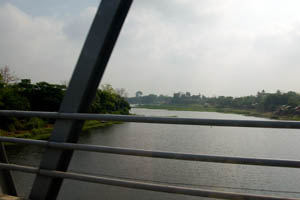
(Delta, Ayeyarwady, Myanmar)
The drive through the Ayeyarwady delta was amongst the highlights of our trip. The delta is a much more lush region than the central plains. The roads are lined by small farms interspersed by market towns typically sited next to a major tributary. We were keen to get to the beach so perhaps did not stop as much as we should have done but we managed to take in some of the scenes of village life.
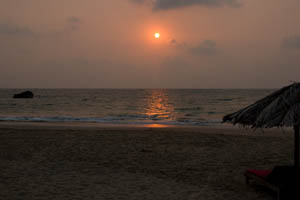
(Ngwesaung, Ayeyarwady, Myanmar)
Myanmar is full of contrasts and after the rural idyll of the delta Ngwesaung initially proved a bit of a shock. You come out of a range of rolling coastal hills to find a perfect white coast inhabited by a series of large five star resort hotels. We opted to stay in the Bay of Bengal Hotel which had slightly more moral credentials. We settled into our ultra-modern bungalow next to the beach and spent the afternoon catching up on sleep and sunbathing.
We were rather tired so did not venture out of the hotel that night, instead having dinner on their deck by the sea. Then, probably incredibly early, we fell asleep listening to the sound of the waves from the Bay of Bengal hitting the beach.
Thursday, 24 April 2014
Ngwesaung, Ayeyarwady, Myanmar
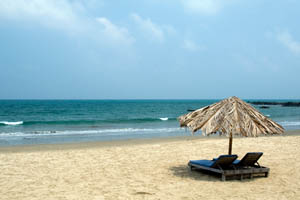
(Ngwesaung, Ayeyarwady, Myanmar)
We had our sights set on a day by the beach and that is exactly what we did. We installed ourselves in a sun lounger and soaked in the sun. This was followed by a leisurely lunch and a siesta.
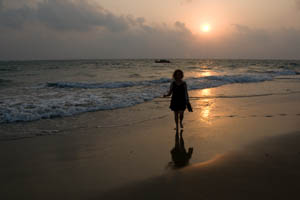
(Ngwesaung, Ayeyarwady, Myanmar)
That evening we walked along the sea front past a couple of kilometres of resorts to the centre of town. There are several restaurants in Ngwe Saung so we found a mid range place and explored the sea food offerings. It was stiflingly hot away from the cooling sea breeze and I started to sweat so profusely the owners of the restaurant found a portable fan and trained it on me.
Friday, 25 April 2014
Yangon, Myanmar
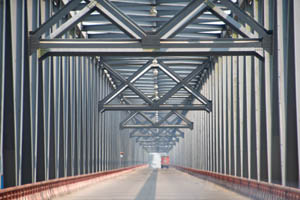
(Yangon, Myanmar)
We had arranged to leave around 1100 so had a few last hours on the beach to enjoy. We then found our driver, another Tun Tun, who was waiting at the hotel lobby to take us back. He had apparently had a house in Ngwesaung so had stayed a couple of nights there. We then trundled back across the delta towards Yangon.
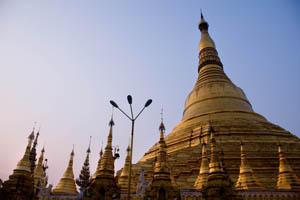
(Yangon, Myanmar)
We had arranged to stay at a hotel near the centre of Yangon so once we had dropped our stuff and had a shower we headed straight out to see the sunset. The place to do this in Yangon is undoubtedly the 96.1496 , towering over the city this is the most sacred Buddhist Pagoda in Myanmar. We arrived by taxi which dropped us at the lift for foreigners, which we ignored, and instead went up the hill via one of the four huge staircases.
Up on the hill the scene was amazing. Hundreds of pilgrims and tourists circulate around a colossal golden central stupa which is in turn surrounded by myriads of smaller shrines. At various points on the route are shrines for days of the week at which people born on the day light candles and pray. Many of the visitors are monks and nuns from other countries, we briefly chatted to a party of nuns from Vietnam.

(Yangon, Myanmar)
Around the outside of the circuit are many other shrines, several of them housing relics of Buddhas. At one we found an amazingly colourful ceremony of children. Just before they become novice monks children are dressed up by their parents and painted almost like dolls apparently in imitation of the world they are leaving behind. We watched for a while then sat on the steps of a nearby shrine to watch the world go by as the sun set.
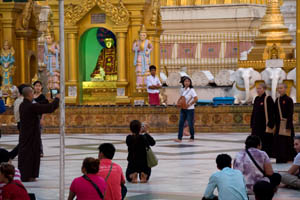
(Yangon, Myanmar)
We probably stayed at Schwedagon for an hour and a half, circling it at least a couple of times trying to take in all the action. We then descending a staircase through throngs of souvenir vendors all hawking their wares. We then walked through Yangon at night to try and find the famous SK Hot Pot.
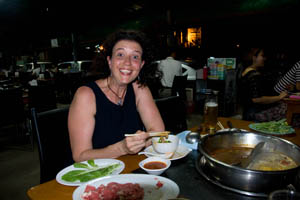
(Yangon, Myanmar)
This was definitely the most entertaining restaurant we went to in Myanmar. You select a variety of meats and vegetables and a waiter brings some broth to your table which he then puts in a heated bowl to bubble away. You then drop your selected ingredients in to cook and eat. It was one of the best meals we had in Myanmar and clearly everyone else thought so as the restaurant was packed to the rafters.
Saturday, 26 April 2014
Yangon, Myanmar
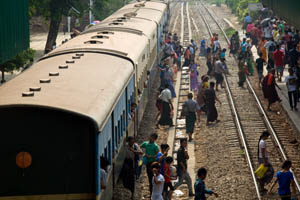
(Yangon, Myanmar)
Our last day we got up early, yet again, to do a walking tour of Yangon. We started off walking past the railway station to the Sule pagoda and glimpsing through the railings of the Maha Bandoola Gardens. Here the rich gather to do their morning exercises, I say the rich because you actually have to pay to get in which seems a bit off for one of the only green spaces in downtown Yangon. From the gardens we walked slowly down Pansodan street towards the river front. This area of Yangon is the colonial core of the city but when the capital was moved to Napyidaw the elegant but dilapidated administrative buildings were abandoned to squatters.
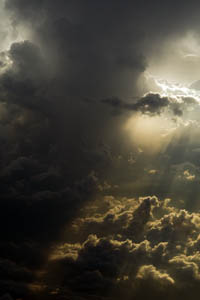
(Yangon, Myanmar)
Even at 0900 the heat was unbearable so after a look at the commuter ferry terminal we popped into the famous Strand Hotel for an orange juice and croissant. After this we walked up to the Thein Gyi street market passing a rather out of place looking synagogue. The market was in full swing and it was a squeeze getting down the narrow alley way past all the fish and vegetable traders. After this we tried to go to Bogyoke market to buy souvenirs, but it had yet to open. So instead we got a cab to a more tourist oriented shop where we snapped up some amazing cushion covers.
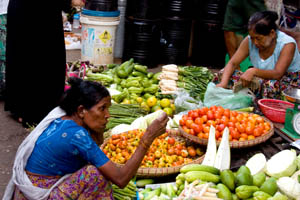
(Yangon, Myanmar)
And that was pretty much it. We had an amazing lunch in our hotel's Sichuan restaurant, but this was more because we did not want to get soaked in sweat again before boarding our plane. We went back via Singapore again and many hours later we stumbled back into our house, glad to be in a slightly cooler climate.







